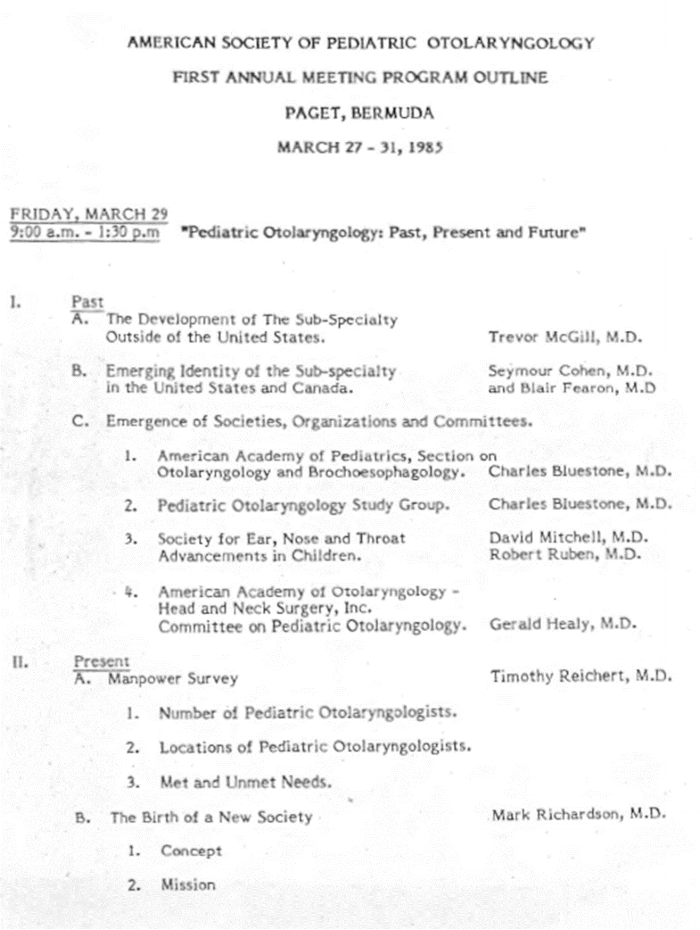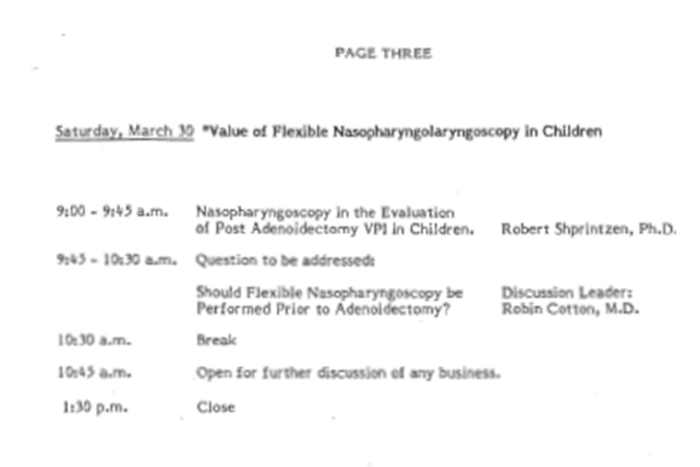History of ASPOBy Robert Ruben, MD, September 2017The origins and early history of the American Society of Pediatric OtolaryngologyAlthough humans have been prey to disease throughout the ages, knowledge about diseases and disorders increases so that our understanding becomes more and more refined. This trend is true with relation to pediatric otolaryngology as well. The understanding of the medical care of children with disorders of the ear, nose and throat evolved quite rapidly during the end of the 19th and the beginning of the 20th centuries. During first part of the 20th century there were a very few physicians who specialized and/or concentrated in the area of caring for some of these disorders in children (1,2), but a child with such disorders was far more likely to be taken care of by a generalist. The precipitating advance for the development of pediatric otolaryngology came about through the successful efforts in caring for premature infants by means of endotracheal intubation. This procedure however, brought with it substantial morbidity of subglottic stenosis for many of the children with subsequent tracheotomy dependence. The seminal work of Fearon and Cotton (3,4)—the new knowledge—lay in the experimental observations that then led to the development of laryngeal reconstruction for these children. This advance led to a number of otolaryngologists concentrating in the care of not only the airway but other aspects of ear, nose and throat diseases in children. 19721972 AAOO meeting in DallasAs more physicians in North America began to concentrate their practice on children, the need arose to bring attention to this development to the broader otolaryngic community. Drs. Sylvan Stool and Marvin Culbertson posted a notice at the 1971 (5) meeting of the American Academy of Ophthalmology and Otolaryngology (AAOO) inviting all those interested in Pediatric ORL to meet informally (6). About 20 physicians attended this initial meeting and it was decided to convene again at the AAOO 1972 meeting in Dallas. A decision was made at the 1972 meeting to form a new society focused on Pediatric ORL, and a small group was formed to write a set of bylaws and incorporate this new venture. 1973The Society for Ear, Nose and Throat Advances in ChildrenThe new society was called The Society for Ear, Nose and Throat Advances in Children, Inc. (SENTAC), and it was founded in 1973 as a non-profit interdisciplinary professional organization. Its members were and continue to be otolaryngologists, pediatricians, surgeons, pediatric otolaryngologists, speech pathologists, audiologists, nurses, and basic scientists – in fact all of those who are interested in enhancing the care of children with acquired or congenital disorders of the ear, nose, and throat. SENTAC continues to be an interdisciplinary forum for new ideas; it is one of the few medical societies in which membership is determined solely by interest, not by professional association, facilitating the successful interchange of information between many different professional and lay groups. 1977Two New GroupsThese informal gatherings continued until 1977 when two new groups were created. These were the Pediatric Otolaryngology Study group initiated in Pittsburg (7) (Figure 1) and the American Academy of Pediatrics (AAP) Section on Otolaryngology-Head & Neck Surgery and Bronchoesophagology (ORL& BE) [1] 
Figure 1. The first meeting of the study group held in Pittsburgh, 1977. Front row: Donald B. Hawkins, Herbert G. Birck, Gabriel Tucker, and William P. Potsic. Middle row: Timothy J. Reichert, Robert S. Shapiro, David P. Mitchell, Charles D. Bluestone, Robin T. Cotton, Blair W. Fearon, and William S. Crysdale. Back row: Sylvan E. Stool, Keith H. Riding, Herman Felder, Marvin C. Culbertson, Jacob Friedberg, Robert J. Ruben, Melvin D. Schloss, and Gerald B. Healy (7). [1] From Allison E. Sergram Allison E. Seagram, Archivist, Division of Library & Archival Services, American Academy of Pediatrics 1979 - 1984BylawsThen, on October 13 -18, 1979 at the San Francisco meeting of the Section on ORL&BE in San Francisco, the concept of a “senior” pediatric otolaryngology society modeled on the American Laryngological Society and the American Otological society was proposed. Mark Richardson was chosen to investigate this possibility and to create a draft of bylaws. This process took some time, but by Mach of 1984 a draft of the by-laws for the new society was circulated to members of the AAP ORL&BE section and to the Pediatric Otolaryngology study group. Many individuals commented and there was a dynamic exchange of ideas and suggested edits which finally led to a consensus, with the result that the final set of bylaws was completed by April 1984. The by-laws for the now named American Society of Pediatric Otolaryngology (ASPO) were presented to a combined meeting of the study group and the AAP ORL&BE section on the 6th of April 1984, in Houston Texas. The objectives of the society were discussed and a training curriculum was proposed. The next day, Saturday the 7th of April 1984, ASPO was initiated with the unanimous approval of the by-laws (8). March 27 - 31, 1985First Annual Meeting of ASPOThe first annual meeting of ASPO took place from March 27 - 31, 1985 at the Elbow Beach Hotel in Bermuda. This was attended by 56 North American physicians (Figures 2 & 3) four of whom were women. The meeting program (Figure 4a, b, &c) articulated many of challenges that remain pertinent today including, a person power needs, and interrelationships with other societies within and beyond otolaryngology, the need for credibility as a specialty, training, sub certification, etc.] 
Figure 2: Attendees at the first annual meeting of ASPO in Bermuda 1985 
Figure 3: List of Attendees at the first annual meeting of ASPO in Bermuda 1985 
FIGURE 4A 
FIGURE 4B 
FIGURE 4C Figure 4a, b, and c: Program of the first annual meeting of ASPO in Bermuda 1985. April 16 - 20, 1986First Annual Scientific SessionThe next meeting was the First Annual Scientific Session of the American Society Pediatric Otolaryngology, from April 16 - 20, 1986 in Santa Barbara, California, with Seymour Cohen, M.D. as our first president. There was an excellent increase in attendance (Figure 5) with more than 65 attendees. 
Figure 5. Attendees at the First Annual Scientific Session of the American Society Pediatric Otolaryngology from April 16-20, 1986 in Santa Barbara, California The program had 35 presentations, including a zebra and an albatross session. The presentations include a very timely invited lecture on Chronic Otitis Media/Sinusitis as Presenting Infection in Pediatric AIDS by J. A. Church, M.D., Los Angeles. Other presentations were concerned with Nasal and Paranasal Sinus Surgery in Children with Cystic Fibrosis; The Use of Tissue Expanders in the Treatment of Giant Facial Congenital Hairy Nevi; Timing of Palatoplasty and Early Speech; Medical Profile of the Language-Delayed Child: Otitis Prone vs. Otitis Free; Use of Ultrasound in Detection of Sinus Disease in Children; Norrie's Syndrome: An Otologic Perspective; Carotid Body and Glomus Jugulare Tumors in Children; Posterior Glottic Pathology; The Effects of Neutralizing Agents on Esophageal Burns Caused by Disc Batteries; and many others. 1987 - 1991ASPO MeetingsASPO then met in 1987 at the Broadmoor in Colorado Springs; in 1988 at The Kiawah Island Resort in Charleston; in 1989 The Marriott Hotel in San Diego; in 1990 at the Four Seasons Hotel, Toronto; and in 1991 at the Hyatt Regency in Waikoloa. 1992Combined Otological Spring Meetings (COSM)As the society grew in numbers and in quality of presentations, the desire arose for recognition as a senior society, in which the membership was determined by substantial credentialing, with nominations from the membership. This was achieved in 1992 (Fig 6), when ASPO joined the other senior societies at the Combined Otological Spring Meetings (COSM) at Marriot Desert Springs Resort in Palm Desert. 
Figure 6: Program of the ASPO meeting at COSM, 1992 ASPO presented 43 platform presentations and 47 posters. There were 316 registrants which brought in $30,3509 (in 2017 $’s 52,989). This initial joint session set a precedent which has been continued ever since for high quality presentations, and very large attendance, both of registrants and “walk-ins”. ASPO is now one of the leading organizations in quality of presentations, diversity of individuals and presentations, and registration numbers supporting the success of COSM. ASPO has maintained its uniqueness by from the very beginning having its own banquet (Figure 7), and in holding every fourth-year meeting away from COSM. ASPO has been and continues to be a success story. 
Figure 7. Invitation to the ASPO banquet at the first meeting with COSM, 1992 (9) References
|




